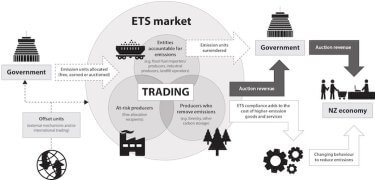
European Union Energy trading system EU ETS
What is European Union Energy trading system EU ETS ?
How does it work?
EU ETS is the cap and trade
for reducing greenhouse gas via a carbon dioxide market. The EU Emission Trading System (ETS) operates on a ‘cap and trade’ principle, limiting greenhouse gas emissions from installations and aircraft operators. The cap is reduced annually to align with the EU’s climate target, reducing emissions by 37% since 2005. Emission allowances are used, with companies surrendering enough allowances to account for their emissions. The declining cap provides certainty about long-term allowance scarcity and market value, encouraging companies to reduce emissions cost-effectively. The EU ETS generates over EUR 152 billion in revenues since 2013, primarily supporting renewable energy investments and low-carbon technologies. Its legislative framework is spelled out in the ETS Directive.Over the years, it has undergone several revisions aligning the system with the overarching EU climate targets. The stated aim of the EU’s Emissions Trading System is to push cost-effective decarbonisation across key sectors of the EU economy. This implies that the EU ETS should complement the EU’s climate actions by reducing emissions from covered sectors to a level that is in line with the Union’s climate goals. At the end of 2021, the EU ETS was required to decrease the combined emissions of all covered installations by 43%, relative to 2005, by 2030. This target was already reached by the end of 2020, indicating that this was not an ambitious climate target. The falling cap will reach zero by 2058, implicitly setting a longer term pathway for full decarbonisation.
The European Green Deal and the Climate Law raised the EU’s climate ambition, with the EU economy-wide emissions reduction target increased to at least 55% from the previous ‘at least 40%’ (both compared to 1990). This higher ambition needs to be translated into sectoral targets. In July 2021, the European Commission proposed to raise the EU ETS target to a 61%
reduction in emissions by 2030 (compared
with 2005).While these higher targets are a step in the right direction, they do not go far enough.
Environmental NGOs are demanding that the EU ETS should aim to slash emissions by 70% by 2030, and that the EU should reach climate neutrality a decade ahead of the current official target by 2040 at the latest to stand a chance of keeping global warming below the crucial 1.5°C threshold and shoulder its fair share of climate action.
How an ETS works ?
An Emission Trading System (ETS) involves the government determining which entities, such as fossil fuel producers, industrial producers, foresters, and landfill operators, are liable for their emissions. They use a trading market to cover their emissions liability and sell unnecessary units. Each liable entity must report emissions and surrender units to the government, influencing consumers to make more climate-friendly choices.
There are several ways for entities to get units.
First,entities can obtain units through free allocation from the government, particularly for trade-exposed industrial producers. Emissions beyond their free allocation require more units, while those with improved processes can sell or bank excess units.
Second, Second, entities can earn units by establishing new forests or through industrial activities that remove emissions. By stripping emissions from the atmosphere, such removal activities make it possible to add units to the cap without increasing net emissions. The government publishes information on ETS emissions and removals every year.
Last,the NZ ETS allows entities to purchase units through auctioning, with market demand setting prices. Emitters can currently buy uncapped fixed-price units at NZ$25. Entities previously had a fourth option to buy offshore units, but this stopped in mid-2015 and is not currently available under the Paris Agreement, potentially necessitating quantity and quality limits.
Reference
https://climate.ec.europa.eu/eu-action/eu-emissions-trading-system-eu-ets/what-eu-ets_en
This article is a part of the class
“751447 SEM IN CUR ECON PROB”
supervised by Asst. Prof. Napon Hongsakulvasu
Faculty of Economics, Chiang Mai University
This article was written by Viyada Bochantuk , and student I.D. 631615054
